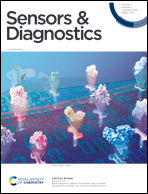Study on inhibitory effects of AsA, ZnCl2, and BAPTA-AM on Cd2+-induced cell oxidative stress and cytotoxicity by scanning electrochemical microscopy (SECM) technology
Abstract
Cadmium (Cd) can cause cell oxidative stress and cytotoxicity. Few studies have focused on inhibitory effects on Cd2+-induced oxidative stress and related cytotoxicity. Scanning electrochemical microscopy (SECM) is a highly sensitive and non-invasive electrochemical analytical method. However, no information exists on inhibitory effects on Cd2+-induced cell oxidative stress using SECM technology. Herein, we studied the effects of ascorbic acid (AsA), zinc chloride (ZnCl2), and calcium chelator 1,2-bis (2-aminophenoxy) ethane-N,N,N′,N′-tetraacetic acid tetraethoxy methyl ester (BAPTA-AM) on cell oxidative stress with SECM. Subsequently, we studied the inhibitory effects of AsA, ZnCl2, and BAPTA-AM on Cd2+-induced cell oxidative stress. Consequently, 50 μmol L−1 AsA, 5 μmol L−1 ZnCl2, and 5 μmol L−1 BAPTA-AM did not produce reactive oxygen species (ROS) and had little effect on cell viability. However, they could significantly reduce Cd2+-induced excessive ROS and alleviate apoptosis (P < 0.01). Additionally, AsA had the strongest inhibitory effects on Cd2+-induced oxidative stress, followed by BAPTA-AM and ZnCl2. The inhibitory effects of AsA, ZnCl2, and BAPTA-AM on Cd2+-induced cytotoxicity might result from directly scavenging ROS and inhibiting oxidative stress-mediated signal transduction, enhancing antioxidant activities and maintaining cell membrane stabilities, and chelating excess calcium2+ (Ca2+) to hinder its subsequent signal transduction, respectively. Scavenging excessive ROS and inhibiting cellular oxidative stress-mediated signal transduction might be the most effective way to alleviate Cd2+-induced cytotoxicity. Our study provides empirical evidence on the inhibitory effects of AsA, ZnCl2, and BAPTA-AM as specialized inhibitors against Cd2+-induced cellular oxidative stress and cytotoxicity, providing precious ideas for detoxifying toxic environmental metal pollutants.



 Please wait while we load your content...
Please wait while we load your content...